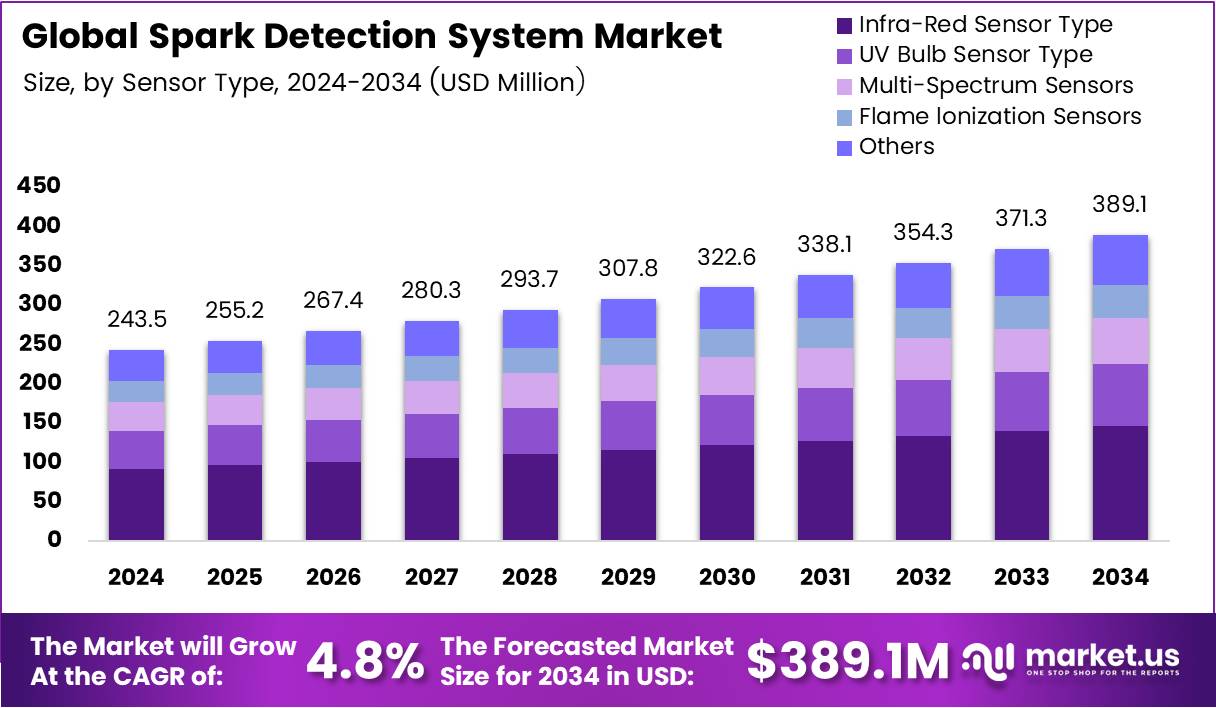Table of Contents
Introduction
The Global Spark Detection System Market is experiencing steady expansion as industries increasingly prioritize advanced fire prevention and workplace safety measures. Valued at USD 243.5 Million in 2024, the market is projected to reach USD 389.1 Million by 2034, growing at a CAGR of 4.8% from 2025 to 2034. This growth reflects rising adoption of automated fire suppression technologies in high-risk production environments.
Industries such as wood processing, pulp and paper, metal manufacturing, and food production continue to implement spark detection systems to reduce hazards associated with combustible dust and high-temperature particle emissions. These systems identify sparks at the earliest stage and activate suppression mechanisms in real time, improving safety and operational continuity.
Moreover, modern manufacturing facilities are transitioning toward data-driven safety infrastructure enabled by IoT, AI analytics, and predictive monitoring. These innovations enhance detection accuracy and support compliance with stringent regulatory frameworks across North America, Europe, and emerging industrial economies in Asia Pacific.

Key Takeaways
- Global Spark Detection System Market projected to reach USD 389.1 Million by 2034 from USD 243.5 Million in 2024, at a 4.8% CAGR.
- Infra-Red Sensor Type leads the sensor segment with a 37.8% share due to superior heat signature detection.
- Point Detection Method dominates with a 42.5% market share, ensuring precise localized spark identification.
- Duct-Mounted Systems account for 46.2% of installations, driven by widespread use in air handling and dust collection ducts.
- Wood Processing Industry leads applications with a 27.3% share owing to high dust explosion risks.
- North America holds a dominant 34.5% market share valued at USD 84.0 Million, driven by strict fire safety regulations.
Market Segmentation Overview
The market includes a diverse range of sensor types, with Infra-Red sensors holding the largest share due to their ability to instantly detect heat signatures and trigger automatic suppression responses. UV and multi-spectrum sensors are also gaining adoption for environments prone to emissions and combustion risks.
By detection method, Point Detection remains the preferred technology for its precision and cost-efficiency. Line and area detection methods are increasingly implemented in conveyor-based and wide operational zones to ensure continuous safety monitoring across extended production pathways.
In terms of installation, duct-mounted systems dominate as they protect ventilation ducts and dust collection pipelines where ignition risks are elevated. Conveyor-mounted and pneumatic transport systems also see growing deployment in material-handling facilities requiring persistent spark surveillance.
By application, the wood processing sector leads due to the presence of airborne sawdust and high-temperature cutting processes. Metal fabrication, pulp and paper, textiles, and food processing plants also integrate spark detection systems to mitigate explosion and fire risks during heat-intensive manufacturing cycles.
Drivers
One of the primary drivers is the rising emphasis on workplace safety compliance in industrial facilities. Government agencies such as NFPA and OSHA mandate advanced fire suppression systems, compelling companies to adopt spark detection solutions to ensure regulatory adherence and risk reduction.
Additionally, increasing automation across production environments is accelerating the need for integrated, real-time detection systems. As industries transition toward Industry 4.0 infrastructure, automated spark monitoring enables faster mitigation, reducing downtime and preventing asset damage.
Use Cases
In woodworking plants, spark detection systems play a crucial role in preventing combustible dust explosions during milling, cutting, and sanding operations. Early spark identification helps maintain air quality and prevent ignition within dust collectors and ductwork.
In metal fabrication facilities, spark detection systems safeguard welding and grinding operations. They detect stray sparks that may ignite hydraulic oils, solvents, or dust deposits, ensuring worker safety and reducing equipment repair costs.
Major Challenges
High installation and ongoing maintenance costs remain a significant challenge, particularly for SMEs. Advanced systems require specialized wiring, sensors, suppression nozzles, and periodic calibration, making adoption costly for companies with limited safety budgets.
Another challenge is the complexity of retrofitting spark detection into older facilities. Legacy infrastructure with outdated duct layouts, power systems, or ventilation units often requires substantial modifications before installation, extending project timelines and increasing expenses.
Business Opportunities
Integration of AI and IoT technology presents strong opportunities for vendors. Smart spark detection systems equipped with predictive analytics can provide real-time risk assessment, enabling proactive maintenance strategies and reducing unplanned downtime.
There is also growing demand for wireless, modular, and scalable detection solutions. Manufacturers seeking flexibility in plant expansion or reconfiguration benefit from systems that can adapt to evolving industrial layouts without extensive reinstallation costs.
Regional Analysis
North America leads the global market due to stringent workplace safety legislation and high adoption of industrial automation. Major industries across the U.S. and Canada continue investing in intelligent fire suppression networks to protect workers and prevent high-cost facility damages.
Asia Pacific is growing rapidly as industrialization accelerates across China, India, Japan, and South Korea. Increasing awareness of combustible dust hazards, major manufacturing expansion, and government-supported modernization initiatives are driving demand for spark detection solutions in the region.
Recent Developments
- In October 2025, a wildfire detection startup secured USD 14 Million in funding to enhance AI-based early warning systems and satellite-supported fire monitoring infrastructure.
Conclusion
The Spark Detection System Market is positioned for sustained growth as industries worldwide prioritize proactive fire prevention and operational safety. Advancements in multi-spectrum sensing, AI-driven monitoring, and automated suppression technologies continue to enhance system reliability and performance. With strong regulatory support and expanding use across high-risk sectors, spark detection systems are becoming an essential component of modern industrial safety frameworks.
Discuss your needs with our analyst
Please share your requirements with more details so our analyst can check if they can solve your problem(s)



